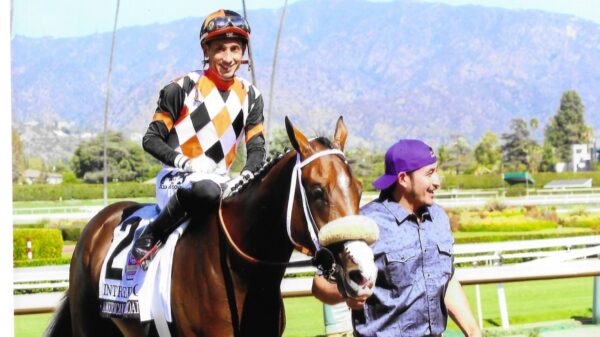The mistake of decoupling entries

Rinaldo Del Gallo, III
By: Rinaldo Del Gallo, III
When a Grade III horse race that is a “Road to the Kentucky Derby” race gets only four entries without one of the four having won their last race out, it has to raise eyebrows. I thought, and maybe I am wrong on this, that decades ago horses that had the same trainer had to be a single entry (horse 3 and 3A), even if they had different ownership interests.
It is not an easy thing to research. This is mostly not the case anymore, but Maryland has a code which reads, “Horses trained by the same trainer shall be coupled, except that when a trainer enters two or more horses in a stakes, handicap, futurity, or other special event, the horses, at the request of the racing association and with the approval of the State Racing Commission, may be permitted to race as separate wagering interests.”
It looks bad
Numerous articles and comments on Facebook pages have written about Bob Baffert and his inability to participate in the Kentucky Derby. At first blush, it might look like people dodged the Grade III Robert Lewis Stakes because Baffert is in it and others are fearing unfair competition. I can’t say this is the case, but it sure does have the superficial appearance of it. I have seen people comment in Thoroughbred Daily News that they will not enter horses at certain racetracks because of alleged widespread cheating.
The tops four finishers of the Robert Lewis Stakes got points for the Road to the Kentucky Derby, which none of the horses will get because Bob Baffert trained horses are not eligible for points.
Not only were four horses trained by Baffert, but two have overlapping ownership interests. Horse number 2 (Newgate) is owned by “SF Racing LLC, Starlight Racing or Madaket Stables LLC, et al.” Horse number 3 is also owned by “SF Racing LLC, Starlight Racing, or Madaket Stables LLC, et al.” Both the number 2 horse and the number 3 horse are owned by the same owners and the same trainers, but are operating as separate betting entities.
In centuries past, one of the horses would have had to have been declared a winner by a common owner. It has been written concerning the great runner and sire Gleneg in the Belmont Stakes, “Glenelg was easily the superior of Belmont Stakes winner Fenian but was held back to allow Fenian to win.” Gleneg was quite the stakes winner and four time leading sire, but Mr. Belmont had him lose to Fenian. And that’s why we couple horses with the same ownership interest.
What is the problem when two horses are entered from the same owner or trainer? There is nothing for them to gain or lose if one comes in first and one comes in second, so there is more of a likelihood that they might fix the race, or even much more likely, not try very hard to win if they see that the other racing entry is the one likely to win.
In the 1973 Marlboro Cup Invitational Handicap, featuring some of the best horses in the nation at the time, Riva Ridge and Secretariat wore the same colors. According to Wikipedia, with a reference to the New York Times, “In the inaugural race, Secretariat set a world record time for 1+1⁄8 miles on dirt while winning by 3+1⁄2 lengths on a track officially rated as being only ‘good’.” The bottom of the screen read, “2 2 1 1.” That’s because there were two number 2 horses (Secretariat and Riva Ridge). (The second 1 was probably just a failure to change the order correctly.) Secretariat was “2B,” and Riva Ridge “2.”
There were two number 1 entries in that 1973 Marlboro Cup, which by the way, was on the biggest of stages and was one of the biggest races of the year. Number 1 was Cougar. Number 1A was Kennedy Road. (It is educational to watch the post parade starting at 3:15, to see the two number 1 horses and the two number 2 horses.) Also of important note, Cougar and Kennedy Road had different owners but raced as a coupled entry anyhow: Mary F. Jones owned Cougar, and Mrs. Mrs. Arthur W. Stollery owned Kennedy Road—of note, that was quite a lot of female owners for the time period (Riva Ridge and Secretariat also being female owned), but that’s another story for another day. But because Kennedy Road and Cougar had the same trainer, Charles E. Whittingham, they were a coupled entry, even though they had different ownership interest! Cougar II was the 1972 U.S. Champion Turf Horse and Kennedy Road, the 1973 Canadian Horse of the Year.
Under the rules in play for the 1973 Marlboro Cup, the 2023 Robert Lewis would have to be a walkover, since all starting horses were trained by the same barn. (It is possible to have walkover if both horses are from the same betting interest.)
The 1973 Marlboro Cup
The story of Gleneg and Fenian is a cautionary tale about letting the same owner and training interest race as different racing entities. Fenian only raced that once as a three-year-old, but his image is on the top of the August Belmont Trophy because Fenian was the first Belmont owned trained horse to win the Belmont. (The stakes race is named after the person, not the racetrack.)
On an interesting note, Key to the Mint would come in last in that 1973 Marlboro Cup in that first race. In 1987 Java Gold won the last Marlboro Cup, and his sire was Key to the Mint.
Bloodhorse Magazine had an article, “NY Approves Rule on Decoupled Entries,” of April 27th of 2015, which reads about the then new rules permitting the decoupling of horses (i.e., not running under the same number) when they are commonly owned: “The rules, subject to a public comment period, permit horses with common ownership to be decoupled for the purposes of wagering in stakes with purses totaling $50,000 or more. Officials noted Kentucky and Texas recently addressed their coupling rules, while California and Illinois have lifted coupled-entry regulations.”
The article said, “Permitting decoupling of entries ‘recognizes that misconduct, such as potential collusion among jockeys of commonly-owned horses, is generally less prevalent in races with greater purses,’” Burns said in his letter. While I think that the possibility of collusion goes down, what about just not driving your horse so there is something left in the tank for the next race? Are you really going to bear down on a stablemate?
On April 27, 2006, Bloodhorse Magazine had an article, “CHRB to End Coupled Wagering Interests.” The article started off with “Coupled entries for wagering due to common ownership should be eliminated, the California Horse Racing Board decided at its meeting Jan. 19 in Arcadia.”
There were four horses in this year’s Robert Lewis with two with common ownership interests. I can’t say that I am a fan of this. The rules in play for the 1973 Marlboro Cup make sense to me–if there is a common ownership or training interest, horses should be coupled.
A four-horse field with the same trainer seems to be a bad idea.








